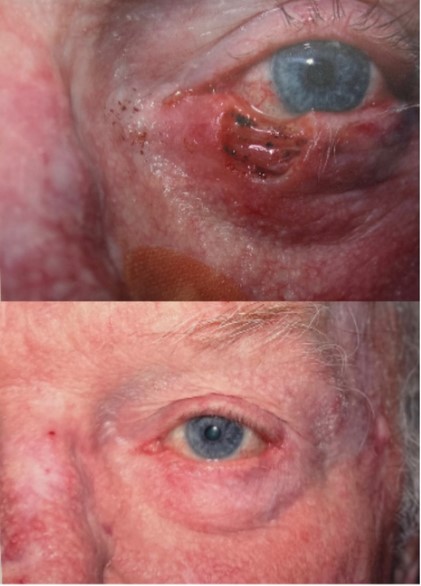Skin Cancer Reconstruction
What is Skin Cancer?
Skin cancer that occurs on or around the eye area is known as periocular skin cancer. Basal cell carcinoma is the most common type of skin cancer around the eyes, followed by squamous cell carcinoma. Melanoma and sebaceous cell carcinoma are less common, but far more serious as it can spread to other parts of the body. If you notice a new bump on your eyelid or an old bump that changes in size, shape, color, bleeds or becomes tender, you should schedule an appointment with a physician as soon as possible.
Skin cancer on or around the eye area, especially on the eyelid, is exceedingly common. The eyelid is easily affected because it is so frequently exposed to the sun. Skin cancer that occurs on the eyelid often appears as a painless bump, a scab that won’t heal, or an area of missing eyelashes. The most common reason for skin cancer is sun exposure, although it may also be hereditary.
What is the Process Like for a Skin Cancer Reconstruction?
The most effective treatment for periocular skin cancers is surgical excision. The process for surgical excision of a skin cancer is reliant on two principles — total removal of the skin cancer and reconstruction of the area. Mohs surgery is the most common surgical technique for removal of skin cancers around the eyes. This procedure is perform by a specialized dermatologist who removes the skin cancer of the lesion layer by layer. After each layer is removed, it is analyzed microscopically to check for any remaining cancer cells. This process is then repeated until the complete removal of the cancerous cells is reached. The goal of Mohs surgery is to remove all of the skin cancer cells while leaving as much healthy skin behind as possible.
After all of the skin cancer is removed, there will be a defect (area of missing skin) that needs to be repaired. Reconstruction of skin cancer defects around the eyes is an area of expertise for the oculofacial surgeon. Our surgeons are experts in the detection, treatment, and reconstruction of eyelid skin cancer. Our goal is to help you maintain your vision, keep your eyes healthy and comfortable, and maintain a natural appearance after your reconstruction.
When Should I Undergo Skin Cancer Treatment?
You should schedule an appointment with your physician as soon as you notice symptoms that could be an indication of skin cancer. Early and aggressive treatment is necessary to ensure a low chance of reoccurrence.
Schedule an appointment if you notice:
- Any changes to the skin around the eye area. This could include a painless bump, non-healing scab, or a group of missing eyelashes.
- Any changes to a mole around the eye area. This could include a bleeding or tender mole; as well as a change in the size, shape, and/or color of the mole.
If you experience any of these aforementioned issues, consider contacting us to set up a consultation with one of our board-certified oculofacial plastic surgeons.
For more on how to prevent skin cancer, click here.
For more information on post-operative care, click here. The content on this page is generalized information and is not medical advice. You will receive your own customized instructions from our providers.
For before and after pictures of our skin cancer reconstruction, click here.
WARNING: The following image sets on this page include graphic images taken directly after reconstructive surgery.
Dr. William Bearden

Skin Cancer Reconstruction
Dr. Nicole Langelier

Skin Cancer Reconstruction
Gallery |
